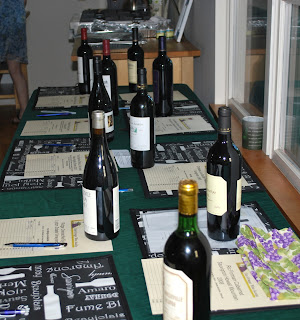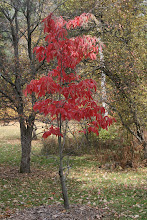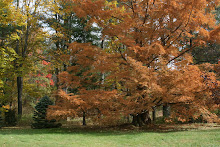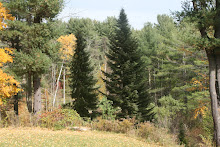Thursday, December 6, 2012
CAMASSIA PLANTS AT PINE HOLLOW ARBORETUM
Wednesday, November 21, 2012
PINE HOLLOW ARBORETUM HOLIDAY CRAFT SALE
Wednesday, November 14, 2012
AN INTERVIEW WITH DAWN REDWOOD
AN INTERVIEW WITH DAWN REDWOOD
Interviewed by Bob Gordon
Hello, Dawn. May I call you Dawn?
That’s OK. Dawn Redwood is my common name. But, ironically, as people get to know me better, they call me by my proper name, Metasequoia. It’s short for Metasequoia glyptostroboides.
Since this is my first interview with you, I’ll call you Dawn. You and your family have moved around quite a lot. Where are you living these days?
My immediate family came to the US from China in 1946. They were seeds brought here by an expedition from the Arnold Arboretum in Boston, who then gave the seeds to arboreta around the country. My family has an interesting history. My ancestors’ fossils had been discovered in the early 1940’s and we were thought to be extinct. But then a couple of years later, a small stand of the trees was discovered in a remote Chinese valley. Despite the excitement, World War II prevented much from happening until our move to Boston in 1946. Then there was another lull in activity as US-China relations chilled. In the 1980’s, after relations between the two countries improved, new seeds were brought to the US. That finally allowed greater genetic diversity among the Metasequoias in the US, since that first group of us all came from just a single collection.
You didn’t answer my question. Does that mean you’re practicing for a career in politics?
No, I just got sidetracked. Sorry. What was the question, anyway? Although I’m about 50 years old, which is certainly not over the hill for my species, I still sometimes forget. Oh, now I remember the question; it was about where I live. My siblings and I live in the arboretum’s Metasequoia Field and Chinese Strip, just over the Japanese Hill. So I guess you could say I’m over the hill after all.
What about your extended family?
My distant cousins, the Coast Redwoods and Giant Sequoias, have lived in California since ancient times, where they grew big and became famous. Their publicity agent says they’re the biggest living things on the planet. I used to think that was just Hollywood hype, but it’s true. And besides, they’re in northern California, not Hollywood.
You sound jealous of your cousins.
No, not at all. I like living in upstate New York where I’m well cared for, with just the right climate and other growing conditions. As one of the 30 featured trees among the 3500 at the Pine Hollow Arboretum, I get all the attention I want.
Are your siblings both brothers and sisters?
Yes, … literally. Each mature Metasequoia contains both male and female cones, like most conifers. But I’m proud to belong to a select group of trees, the deciduous conifers. So like larches and just a couple of other trees, I have needles that turn color in the fall then drop off for the winter.
How many siblings do you live with? What are their names?
I have six siblings. They’re all named Dawn Redwood, too. By the way, there is no truth to the rumor that we Dawns gave Bob Newhart the idea for the brothers Larry, Darryl and Darryl.
You’re denying a rumor. Are you sure you’re not going into politics? If you’re all called Dawn Redwood, how do you identify yourselves?
We were all born in the late 1960’s and 70’s, so we distinguish ourselves by where and how we grow. I’m the widest, but my doctor, a tree surgeon, says I’m not overweight. Another Dawn is the tallest, since it’s able to grow very straight. Our colors are a little different, too. One of us has yellowish foliage; another one has light green foliage. Another sibling is distinguished by its dark trunk. Among the seven of us, the two tallest are more than 70 feet and still growing. Since Metasequoias are fast-growing trees, two others getting there quickly. The other three are still waiting for their adolescence.
Do you have marks on a closet door that show how much you’ve grown?
Don’t be silly. We outgrew closet doors years ago. My siblings and I started being measured two years ago when the American Conifer Society requested that our heights be monitored as part of a nationwide project to learn more about Metasequoias. People still don’t even know how big we can get or how long we can expect to live because there aren’t any old trees or family records in existence. That’s because many years ago the Chinese villagers used Metasequoias for lumber. Some people think we can live 400 or 500 years. Check back with me in a couple of hundred years and I’ll let you know if I’m having a mid-life crisis.
Do you have any children?
My siblings and I have all put down roots in Slingerlands and have decided to raise families here. The four oldest of us are already producing cones and we have produced seedlings.
You mentioned the ideal climate in upstate New York. Are you concerned about climate change?
Metasequoias are one of the few species that won’t be hurt by a little warming as long as we get the right amount of moisture. We can also tolerate temperatures that are much colder than what we get here. While a warming trend won’t affect me personally, I am still deeply concerned about the effects of climate change on other trees and on the whole planet. The edge of Hurricane Sandy didn’t damage any of us at the arboretum, but with more occurrences of extreme weather as the planet warms, I’m not sure we’ll continue to be so lucky.
I share your concern. I’ve enjoyed speaking with you and feel that I’ve gotten to know you better. Thank you, Metasequoia.
---Bob Gordon
Tuesday, October 30, 2012
HONEYLOCUST, BLACK LOCUST AND KENTUCKY COFFEETREE
Pine Hollow Arboretum Board member and accomplished area gardener Audrey Hawkins has contributed this article on her favorite tree, the Kentucky Coffeetree, and two of that tree's close relatives. All three species are included in Pine Hollow Arboretum's collection. Audrey says her favorite tree is the large Kentucky Coffee tree she has growing in her own yard.
Honeylocust (Gleditsia triacanthos), Black Locust (Robinia pseudoacacia) and Kentucky Coffeetree (Gymnocladus dioicus) are all in the Fabaceae Family
Bark of Kentucky Coffeetree
Bark of Black Locust
These three trees, native to the northeastern and mid-Atlantic United States have a lot in common but many ways to tell them apart. Being relatives of the pea family they all have seeds that are encased in a pod-like structure. The pods ripen and turn dark brown in October. Honeylocust has long narrow pods from 8 to 18 inches long and an inch wide that twist into irregular shapes. Kids like to use them as a rattle. The Kentucky Coffeetree has pods 5 to 10 inches long and 2 inches wide with a very leathery surface. Black Locust has a smooth flat pod that is 2 to 4 inches long.
All three trees have leaves that are either pinnately compound, bipinately compound or a mixture of both. All three have alternate leaf placement.(See below for illustrations of a compound leaf). The Honeylocust has both kinds of leaves. The bipinnate leaves on the Honeylocust are 6 to 8 inches long as are the pinnate leaves. The Kentucky Coffeetree has bipinnate leaves that are amazingly 36 inches long and 24 inches wide. The Black Locust has pinnate leaves that are 6 to 14 inches long. Both the Kentucky Coffeetree and the Black Locust have leaflets that are a deep shade of green with a blue tinge. The Honeylocust has much lighter hued green leaves that tend to drop off earlier in the fall season then the other two. All three have leaflets that are between 1 to 2 inches long and oval in shape. The Coffeetree has pointed leaflets.
Pinnately Compound Leaf from Kentucky Coffeetree (L) and Honeylocust(R)
One is most likely to see the Honeylocust tree because after the loss of many of our American Elm trees this tree was planted as a street tree. Many cultivars were developed which eliminated the prickles along the stem of the species and eliminated the pods. Unfortunately this tree has developed many diseases and insect problems that are exacerbated by planting many of the same kind of tree along an avenue instead of a diversity of species. The bark of a long established Honeylocust is rough and furrowed of a grey/brown color. The tree became especially popular with landscapers because it was easy to transplant and grew in many different kinds of situations. Also one can grow grass under this tree because it casts just a light shade.
Pinnately Compound Leaf from a Black Locust
The Black Locust is considered a weedy tree because it sprouts from the roots so you frequently see it growing in a grove. Because of this characteristic it is a good tree to plant on a slope that you are trying to stabilize or along highways and areas where tree cover would be an advantage. It’s not fussy about soil. Not good for a specimen tree on a lawn area for you will constantly be mowing down the sprouts. The bark of the mature tree forms long furrowed very deep ridges of a grayish color. It has prickles along the stems. There are numerous cultivars that have been developed mostly by European breeders that have mostly eliminated the prickles.
My real favorite is the Kentucky Coffeetree. The bipinnate leaves are so unusual being so large and the tree has a strange knobby look in the winter once the leaves have fallen. It has an interesting bark with scale like ridges but a beautiful pattern to the bark. It was once common in New York State and hopefully more will be planted for it has no diseases or insects of importance. It got its common name because when coffee was in short supply in Kentucky, the beans were roasted and made into a kind of coffee. It is said that the leaves and seeds are toxic to man and beast but roasting kills the toxins in the beans. There has been some progress made to develop cultivars. Also cloning only male trees so they do not have pods on them prevents a messy situation on a lawn. The species is a large tree, 75 feet at maturity so it would best be planted in parks or other large areas.
All three of these trees are hardy in Zone 4 to 8 since they are native to the Northeastern US.
---Audrey Hawkins
Tuesday, October 2, 2012
INVITATION TO OUR FALL FESTIVAL
Sunday, October 28, 2012
1:00 p.m. to 4:00 p.m.
At the Visitor's Center
(16 Maple Avenue, Slingerlands)
Activities Include:
Aborteum Tour led by John Abbuhl starting at 2:00 p.m.
Pumpkin Scavenger Hunt
Pumpkin Carving
Collage Making
Letterboxing for Families
30 Significant Trees Self-Tour
Final viewing of Art Show featuring 30 local artists.
Come and enjoy the season!
Saturday, September 15, 2012
ART SHOW AND SALE
Friday, September 14, 2012
AUGUST MADNESS AT PINE HOLLOW ARBORETUM
On August 26th, forty-six Fort Orange Wine Society (FOWS) members and friends took part in Dr. John’s summer excitement at Pine Hollow's Maple Avenue office building - and $4500 was donated to Pine Hollow Arboretum from the proceeds and silent auction! It wouldn’t have been possible without the efforts of John and Kay Abbuhl, David and Susan Pratt, and the FOWS folk who worked with them.
Additionally FOWS members donated wines valued at more than a thousand dollars for the silent auction where only one wine sold below its value price! Successful bidders were generous and went home with some outstanding wines.
FOWS members Maura Gannon and Jim Linnan of Taste donated the delicious food, and Julie and Sami of their banquet staff provided quiet, friendly, and professional service.
Ralph Bonavist of Allstar Wine and Spirits in Latham donated a case of bodacious bubbly to help slake the thirst of a warm day, and four more wines provided the conversational lubricant. (If you want the tasting notes, contact Stu Horn at stuhorn@gmail.com).
If you missed it you missed a terrific afternoon: beautiful weather; Dr. John’s inimitable Arboretum walking tour; wonderful contemporary music by two talented musicians; but most of all the relaxed camaraderie of FOWS people enjoying themselves for a most worthy cause.
write-up by Stu Horn
Sunday, September 9, 2012
SUMMER OF ACTIVITIES AT THE ARBORETUM
• Thanks to being recipients of grant funds, we developed an educational curriculum that allowed us to partner with the local school district to bring elementary students onsite to teach them about our unique collection of trees.
• Thanks to a significant donation, we hired a SUNY Environmental Science intern who worked onsite for 8 weeks. Some of her projects included: studying the biodiversity of the property, creating and displaying new signage, continuing our efforts to label all of our trees, managing our Facebook page and helping to create a letterboxing (scavenger hunt) series.
• The Breathing Room Yoga Studio held yoga classes at the Visitor’s Center and in the metaseqouia field. What fun!!
• The Rootdrinker Institute and Delmar Writers Group held a series of poetry readings at the Visitor’s Center.
• We created a letterboxing (outdoor scavenger hunt) series. You can find our letterbox clues on AtlasQuest.com.
Fall is a beautiful time to visit the arboretum. We hope you will come and enjoy the property. With the lack of rain over the summer, the leaves are expected to change color earlier than usual. We will keep you posted on when this starts to happen
Friday, August 3, 2012
SUMMERGREEN
Monday, July 23, 2012
PHOTOGRAPHY OF PINE HOLLOW ARBORETUM NEEDED FOR OUR 2013 CALENDAR
Format will be similar to 2012 Calendar and once again done by Delmar’s Benevolent Bird Press
Deadline for Submissions is September 1, 2012
Photo file must be sent by e-mail to Calendar Editor Alan Casline at ACASLINE@aol.com
Please send maximum of five different photos for consideration
Photos do not have to be from current calendar year. They do have to be taken on Pine Hollow Arboretum ground
Be aware the reproduction of photos will be of only medium quality. If that is a concern, you probably should not submit.
Wednesday, July 18, 2012
Summer Sunday Afternoons at the Arboretum
a self guided tour of "30 significant trees", letter boxing for beginners, introduction to nature journaling, and a variety of nature crafts . Light refresments available...Enjoy the season and the property!
Saturday, June 23, 2012
Subject: Gary Lawless: 2 Poems Live @ Pine Hollow Arboretum 15-June-2012
This video is now live. What a great time!
One of my favorite poets in a great space to read!
Check out this video on YouTube:
Gary Lawless: 2 Poems Live @ Pine Hollow Arboretum 15-June-2012
http://www.youtube.com/watch?v=IQ-qBzaIRAI&feature=youtube_gdata_player
from obeeduid~
Thursday, May 31, 2012
Yoga at the Arboretum
Wednesday, May 2, 2012
We would like to invite you to join us at the Arboretum this weekend May 5 and 6th, 2012 to launch our new season. The Maple Avenue Visitor's Center will be open from 10 to 4 both Saturday and Sunday. Come and see how many of the newly identified "30 trees" you can name. Bring the kids to enjoy a letterboxing experience. Letterboxing is an environmentally friendly activity that is a fun way to explore the Arboretum and is similar to a treasure hunt. Also, John Abbuhl will be offering a guided tour both days after 2 pm. Light refreshments will be offered.
Hope to see you there!
Thursday, April 12, 2012
ARBORETUM TO ARBORETUM BIKE RIDE
Pine Hollow Arboretum in Slingerlands, New York to The Landis Arboretum in Esperence, New York
http://pinehollowarboretum.blogspot.com/
www.landisarboretum.org/
75 miles round trip
May 19, 2012 (rain date May 20, 2012)
route: http://ridewithgps.com/routes/969105
Mohawk Hudson Cycling Club link:
http://webmhcc.org/rn/modules.php?name=Ride_Calendar&file=ride_report_fancy
The first annual Capital Region Arboretum To Arboretum Bike Ride will take place on May 19, 2012. Please join us! We will begin at 9 am at the Pine Hollow Arboretum in Slingerlands, NY and ride to the Landis Arboretum in Esperence, NY, where we will stop at their annual plant sale, which includes an extensive array of tasty baked (carbohydrate!) offerings! Participants may also begin at the Landis Arboretum, where there is extensive parking, leaving there at approximately 12:30 pm.
Parking at Pine Hollow is limited but available, including space at a nearby church.
To sign up, and for more information, please contact Paul Winkeller, Arb to Arb Ride Leader and Pine Hollow Arboretum Board Member @ winkp@nycap.rr.com
Sunday, March 11, 2012
WILD EDIBLE PLANTS WORKSHOP AT PINE HOLLOW ARBORETUM
Pine Hollow Arboretum presents a Workshop on Wild Edible Plants. Taught by Anita Sanchez, a local author and environmental educator, the workshop will be held on March 25 from 1-4pm in the Arboretum’s classroom and outdoors on the nature trails.
Friday, March 2, 2012
A CALL FOR VOLUNTEERS 2012
Despite the recent snow fall we are sure Spring is on the way! We wanted to send out a short update on what's been going on behind the scenes at Pine Hollow Arboretum. We’ve had a busy winter planning for an exciting opening season. John Abbuhl has placed his annual tree orders and will again be planting throughout the arboretum this spring. We have also planned a number of programs and educational activities for our members and friends of the community so they can continue to experience the beauty of the property. This is all in addition to ongoing gardening and upkeep projects.
We have so much on our “To Do” list that we thought we’d put the word out asking for some extra hands to pitch in. You know the saying, many hands make light work. If you are interested in getting involved please consider volunteering. Some of our needs include: staffing the visitor center (flexible hours), help with gardening projects, cataloging and maintaining our collection database, beautifying our grounds and pitching in at various events throughout the year and more.
Since we are a not-for-profit organization volunteers are vital to our success! We will be having our first informational volunteer meeting at the Visitor Center (16 Maple Avenue, Slingerlands) on the 1st day of Spring, Tuesday, March 20 @ 10 a.m. We hope you can come. Please RSVP by contacting us at (518)439-6472 to let us know of your interest in helping out and by all means bring and/or tell a friend!!
Monday, January 30, 2012
American Holly at Pine Hollow Arboretum
 Green Leaf and Red Berry on a December Day at Pine Hollow
Green Leaf and Red Berry on a December Day at Pine HollowWelcome Winter! Tis the most wonderful time of the year! Seems strange though that we have not seen much snow whirling about but soon enough I’m sure. I love winter at the arboretum. Something about the way the bare branched trees create a level of transparency throughout the woods. It makes the pines and the ponds seem to standout even more. The birds are especially noticeable and fun to watch; the way they dart about yet seem to hang around curious about these strange two legged creatures in their space.
 One of my favorite winter berry trees at the arboretum is the American Holly Tree or Ilex opaca. There is a big male one that can be found at the beginning of the Fir Trail and then a couple female ones with red berries in the vicinity. As you probably know, the holly tree is a popular ornamental tree during the winter holiday season because of its attractive red fruit and dark green leaves. It can grow to be 15 to 30 feet tall. It has a smooth gray-brown bark and a dense crown. The evergreen leaves are lined with sharp spiny edges. The tree produces a greenish-white flower
One of my favorite winter berry trees at the arboretum is the American Holly Tree or Ilex opaca. There is a big male one that can be found at the beginning of the Fir Trail and then a couple female ones with red berries in the vicinity. As you probably know, the holly tree is a popular ornamental tree during the winter holiday season because of its attractive red fruit and dark green leaves. It can grow to be 15 to 30 feet tall. It has a smooth gray-brown bark and a dense crown. The evergreen leaves are lined with sharp spiny edges. The tree produces a greenish-white flower
 Light green trees in background of photo are American Holly
Light green trees in background of photo are American Hollyfrom April thru June which is replaced by red berry-like clusters in the fall. The tree is native to the eastern and gulf regions of the U.S. The holly tree prefers moist soils such as on the borders of swamps but on the other hand thrives on drier soils in protected areas such as along the coast behind sand dunes. It is slow growing and is not reliably cold hardy throughout New York State which makes the arboretum’s specimen so special. The evergreen leaves and berries provide shelter and nourishment to birds of all kinds.
One additional piece of information that I found while doing research on this tree was that the Holly tree has a significant place in history. A study of all colonial gardens of Virginia shows that Holly trees were a favorite of them. Also, there are a number of entries in George Washington’s diary referencing Christmas Holly. In one instance he recorded that he transplanted many little Hollies from the woods but then confessed that his transplanting experiment failed and they died. He apparently tried again because today thirteen of the Hollies that Washington planted still stand. Amazing!
Enjoy the cold winter season!

Post Written by Sue Abbuhl
Photos December 2011 at Pine Hollow by Alan Casline































